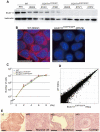ECAT11/L1td1 is enriched in ESCs and rapidly activated during iPSC generation, but it is dispensable for the maintenance and induction of pluripotency
- PMID: 21637830
- PMCID: PMC3102727
- DOI: 10.1371/journal.pone.0020461
ECAT11/L1td1 is enriched in ESCs and rapidly activated during iPSC generation, but it is dispensable for the maintenance and induction of pluripotency
Abstract
The principal factors that lead to proliferation and pluripotency in embryonic stem cells (ESCs) have been vigorously investigated. However, the global network of factors and their full signaling cascade is still unclear. In this study, we found that ECAT11 (L1td1) is one of the ESC-associated transcripts harboring a truncated fragment of ORF-1, a component of the L1 retrotransposable element. We generated an ECAT11 knock-in mouse by replacing its coding region with green fluorescent protein. In the early stage of development, the fluorescence was observed at the inner cell mass of blastocysts and epiblasts. Despite this specific expression, ECAT11-null mice grow normally and are fertile. In addition, ECAT11 was dispensable for both the proliferation and pluripotency of ESCs.We found rapid and robust activation of ECAT11 in fibroblasts after the forced expression of transcription factors that can give rise pluripotency in somatic cells. However, iPS cells could be established from ECAT11-null fibroblasts. Our data demonstrate the dispensability of ECAT11/L1td1 in pluripotency, despite its specific expression.
Conflict of interest statement
Figures





References
-
- Evans MJ, Kaufman MH. Establishment in Culture of Pluripotential Cells from Mouse Embryos. Nature. 1981;292:154–156. - PubMed
-
- Thomson JA, Itskovitz-Eldor J, Shapiro SS, Waknitz MA, Swiergiel JJ, et al. Embryonic stem cell lines derived from human blastocysts. Science. 1998;282:1145–1147. - PubMed
-
- Takahashi K, Tanabe K, Ohnuki M, Narita M, Ichisaka T, et al. Induction of pluripotent stem cells from adult human fibroblasts by defined factors. Cell. 2007;131:861–872. - PubMed
-
- Takahashi K, Yamanaka S. Induction of pluripotent stem cells from mouse embryonic and adult fibroblast cultures by defined factors. Cell. 2006;126:663–676. - PubMed
Publication types
MeSH terms
Substances
LinkOut - more resources
Full Text Sources
Molecular Biology Databases

